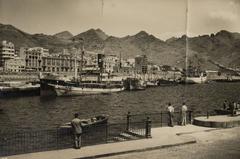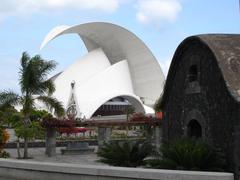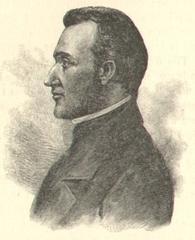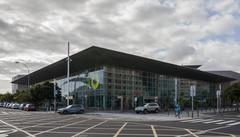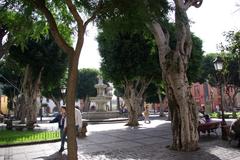
Port of Santa Cruz de Tenerife: Visiting Hours, Tickets, and Travel Guide
Date: 14/06/2025
Introduction
The Port of Santa Cruz de Tenerife is a vibrant gateway to the Canary Islands, blending a rich maritime history with modern infrastructure and cultural attractions. Located on the northeastern coast of Tenerife, it has evolved from a natural Guanche harbor into a bustling commercial and cruise hub. Visitors arriving at the port can expect not only efficient facilities but also immediate access to the city’s architectural gems, historic landmarks, lively markets, and scenic vistas. This comprehensive guide covers everything you need to know about visiting the port—its history, economic significance, visitor information, travel tips, and nearby attractions, ensuring your experience in Santa Cruz is unforgettable (Nomads Travel Guide, Out of Office Mindset, Wikipedia, Spain-Tenerife.com, CruisePorts.co, Cruising Kids, hellocanaryislands.com).
Historical Overview
Early Origins and Development
The port area was originally used by the indigenous Guanche people as a natural harbor, vital for fishing and trade. The Spanish conquest began here in 1494, with Alonso Fernández de Lugo establishing a fortified settlement after the decisive Battle of Aguere, recognizing the strategic importance of the site (Nomads Travel Guide, Out of Office Mindset).
Colonial and Military Significance
Through the 16th and 17th centuries, Santa Cruz flourished as a stopover on transatlantic routes, exporting local products like wine and cochineal. Defensive structures such as the Castillo de San Cristóbal were constructed to protect against pirates and invasions (Web Tenerife). In 1797, Admiral Horatio Nelson’s attempt to capture the port was famously repelled, a victory celebrated in local history.
Urban Expansion and Modernization
Santa Cruz became the capital of the Canary Islands in 1833, spurring port and city expansion. The 20th century brought modernization, expanded docking facilities, and inter-island ferry services, transforming the port into one of Spain’s busiest for both cargo and passenger traffic (Spain-Tenerife.com, Nomads Travel Guide).
Contemporary Significance
Today, the port handles around 23% of all sea passengers in the archipelago and is a leading cruise destination, recognized for efficiency and service (Wikipedia). Its location near two international airports enhances its global connectivity.
Practical Visitor Information
Port Visiting Hours and Access
- General Access: The port area is open to visitors year-round. Pedestrian access to public areas is typically from 8:00 AM to 8:00 PM.
- Cruise Terminal: Operates daily from 6:00 AM to 10:00 PM in alignment with cruise schedules.
- Specific Facilities: Museums and historic sites near the port may have individual hours and holiday closures. Always check ahead.
Tickets and Guided Tours
- General Entry: Access to the port and waterfront is free.
- Attractions: Museums (e.g., Casa del Carnaval, Museo de la Naturaleza y Arqueología) and botanical gardens may charge €3–€10 per adult. Guided walking tours are available through local operators and can be booked online or at the port information desk.
Accessibility
- The port and most nearby attractions are wheelchair accessible, with ramps, elevators, and accessible restrooms.
- Assistance services are available upon request; contact the port authority or cruise line in advance for arrangements (CruisePorts.co).
Top Attractions Near the Port
| Attraction | Distance | Visiting Hours (2025) | Admission | Highlights |
|---|---|---|---|---|
| Plaza de España | 5 min walk | Open 24 hours | Free | Central square, architecture, events |
| Mercado de Nuestra Señora de África | 15 min walk | 9:00–14:00, 17:00–20:00 | Free | Local foods, crafts, shopping |
| Auditorio de Tenerife | 15 min walk | 9:00–21:00 (varies) | Varies | Iconic architecture, performances |
| Castillo de San Juan Bautista | 15 min walk | Exterior open daily | Free | Historic fortress, coastal views |
| Palmetum | 15 min walk | 9:00–19:00 (seasonal) | €6 | Botanical gardens, palm collections |
| Parque Marítimo César Manrique | 15 min walk | 10:00–19:00 | €5 | Pools, sunbathing, leisure |
Other notable sites include the Iglesia de la Concepción (open daily, free), the Museum of Nature and Archaeology (open Tue–Sat 10:00–18:00, Sun 10:00–15:00, €5), and the Tenerife Espacio de las Artes (TEA) (open Tue–Sat 10:00–20:00, free for permanent exhibitions).
Economic and Cultural Significance
Economic Role
The port drives Tenerife’s economy, supporting over 31,000 jobs and generating €1.48 billion annually (hellocanaryislands.com). It is a crucial hub for freight, inter-island ferries, and one of Spain’s top cruise ports, welcoming about one million cruise passengers in 2018.
Tourism and Commerce
Tourism is central to the port’s economic output, with seamless cruise operations and modern terminals. The surrounding commercial sector thrives, supported by markets, shops, and services catering to global travelers (puertosdetenerife.org, tenerifeweekly.com).
Cultural Heritage
Santa Cruz’s identity is intertwined with its port, from its defense against Nelson to vibrant annual events. The Carnival of Santa Cruz, the second largest in the world, brings energy and color to the port area each year (facts.net). The city’s architecture, public art, and gastronomy reflect its maritime legacy and cosmopolitan character.
Travel Tips
- Getting There: The port is 10 km from Tenerife North Airport and 60 km from Tenerife South Airport. Taxis, buses, and trams are available.
- Transport: The Intercambiador de Transportes bus station is nearby; trams link to La Laguna and other destinations.
- Accessibility: Most attractions are accessible; some historic sites may have uneven terrain.
- Weather: The climate is mild year-round; bring sun protection and comfortable shoes.
- Currency & Language: The euro (€) is used; Spanish is spoken, but English is common in tourist areas.
- Health & Safety: Pharmacies are nearby; 112 for emergencies. The port and city center are considered safe.
- COVID-19: Observe current health protocols as needed.
Frequently Asked Questions (FAQ)
Q: What are the port’s opening hours?
A: The port is generally open from 8:00 AM to 8:00 PM for public areas; the cruise terminal operates 6:00 AM to 10:00 PM.
Q: Is there an entry fee for the port?
A: No, general access is free. Some museums and guided tours require tickets.
Q: Are guided tours available?
A: Yes, bookable online, at tourist information centers, or through cruise operators.
Q: Is the port accessible for those with disabilities?
A: Yes, with ramps, elevators, and assistance services available.
Q: How do I buy attraction tickets?
A: Online, at attraction entrances, or at the port information desk.
Q: What’s the best way to get to Playa de Las Teresitas?
A: Taxi or public bus; about 15 minutes from the port.
Summary and Encouragement to Explore
The Port of Santa Cruz de Tenerife is more than a transportation hub—it’s a dynamic intersection of history, culture, and commerce. Travelers can immerse themselves in centuries-old stories, explore world-class architecture, shop at bustling markets, and relax in urban parks or on nearby beaches. The port’s modern facilities ensure comfort and accessibility for all, while its proximity to key attractions allows for easy, enriching exploration of Tenerife’s capital. Make the most of your visit by planning ahead, taking guided tours, and enjoying the local gastronomy and festive spirit. For up-to-date information, event listings, and exclusive offers, consider downloading the Audiala app and following official tourism channels (Nomads Travel Guide, Out of Office Mindset, Wikipedia, Spain-Tenerife.com).
Sources and Official Websites
- Nomads Travel Guide
- Hello Canary Islands
- Port Authority of Santa Cruz de Tenerife
- Cruising Kids
- Wikipedia
- Out of Office Mindset
- Spain-Tenerife.com
- Tenerife Weekly
